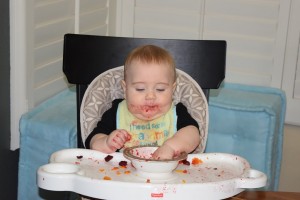Kids are known for being picky eaters. Typically, many seem to prefer crustless white bread, chicken nuggets, french fries, plain pasta, macaroni and cheese, etc. Getting them to eat things outside of their food boundaries is a struggle for many parents, resulting in dinner-time showdowns and separate meals. Biologically speaking, it makes sense. Young children instinctively stick to foods that they are used to getting, typically plainer foods, because being adventurous with what to eat in the wild could result in poisonous plants being ingested.
Here are some suggestions to get your kids to eat and enjoy, yes enjoy, those vegetables. Remember that this is a very normal stage for children and that patience and persistence is key.
10 Ways to Get Your Kids to Eat More Vegetables:
- Start them young and keep it up. Breastfed babies are exposed to a wide variety of subtle flavors through breastmilk. When we first give babies solid food, we often strive to provide organic whole fruits and vegetables. Babies first foods are often very nutritious: avocados, sweet potatoes, carrots, etc. But I noticed that there seemed to be fruit added to every vegetable, making every experience with food very sweet. Not all vegetables are sweet, so it’s important that babies grow accustomed to a variety of flavors. Dominik didn’t always like it, but the important thing was that he experienced the flavor. As they grow into finger foods, many of us start providing “kid friendly” foods and easy snacks. Plain cereals, plain noodles, cut up chicken nuggets, and many other typical “kid” foods make their way into our children’s meals. I often find myself grabbing the peanut butter and bread for Dominik’s lunch instead of the veggie packed leftovers I saved for myself. Start the vegetables when you choose to feed solids, but keep it up, avoiding sweetening each one.
- Make them taste yummy. Sometimes vegetables are an afterthought. They are quickly steamed as a sad side to a flavorful and filling meal. I hate steamed vegetables, especially if they come from a can or were frozen. They are usually mushy and bland and I don’t blame kids for not wanting to eat that pile of flavorless peas. Use fresh vegetables, spices, seasonings, and different preparations to make them flavorful and interesting. It doesn’t have to be overly complicated; a simple roasted broccoli with garlic, salt, pepper, and a squeeze of lemon juice is one of Dominik’s favorites.
- Be a role model. If your child looks over to your plate full of untouched vegetables or watches you grimace through a mouthful of spinach, chances are they are not going to want to eat it. Make a point to talk about how yummy the vegetables are, using good descriptive words like: fresh, zesty, rich, creamy, crunchy, sweet, etc. Seeing you eat and enjoy the foods that you want them to eat makes them warm up to them much more easily.
- Offer them at every meal. Your child will most likely not eat everything that you put in front of them every time you sit to eat. Dominik will love zucchini one day, and push it off of his plate the next. But instead of coming to the conclusion that he doesn’t like zucchini, I’ll offer it again another day, not making it a huge deal if he doesn’t eat it. By providing them with vegetables every meal, the constant exposure will familiarize them with these foods, making them not so foreign and scary. It takes more than one taste of something for a child to like a food. Just because they refused it once or twice or even three or four times, doesn’t mean they will refuse it again. We did this with mushrooms, and pretty soon they became a favorite!
- Include the kids in food planning and preparing. When children see the process of making something and participate in it, two things happen. The first is that they become more familiar with that particular food because they have handled it, looked at it, and manipulated it. It brings down the barrier between the child and the food. Second is that they become proud of creating something and want to enjoy the rewards. If I worked hard on a meal, I love to sit and enjoy it.
- Let them play first. There was a study done not too long ago that found that kids that participated in physical play before lunch ate more vegetables than those that had recess after lunch. This makes sense. First, kids will speed through a meal so that they can play, only eating the minimum of what they prefer to eat. Also, being physical gets the metabolism active and works up an appetite, making those vegetables more appealing than if they weren’t really that hungry anyway.
- Don’t offer rewards. This may sound counterintuitive but seriously, don’t offer rewards like extra dessert if they eat their vegetables. This reinforces the idea that vegetables are not as good as the other items on their plate. If they were just as good, why would a reward be provided for eating those and not the other stuff? By being intrinsically motivated to eat vegetables, they not only feel in control, but they eat vegetables because they want to and not because they have to. This will make lasting eating habits more likely as well.
- Share your food. Sometimes Dominik refuses a meal. He pushes stuff around the plate and looks at me while throwing food onto the floor. When this happens, I swap plates. Have you ever been to a restaurant with someone and thought about how their food looked more appetizing than yours? Sometimes, just the fact that it is on my plate makes the food appealing to Dominik, even if it’s the exact same thing. So we swap and he happily eats my food. Even letting him take just a few bites off my plate helps as well.
- Don’t make separate meals. If Dominik cannot have it, I will not make it. This really isn’t as hard as it sounds because adult meals are just as good for young children. As long as it is healthy and doesn’t have alcohol or it’s not too spicy, they can eat it. By serving Dominik what we are eating, we are making sure that his tastebuds and tastes are used to things with a variety of flavors. If we gave in to give things that we know he would prefer, we would be reinforcing the idea that he gets to eat whatever he feels like, which is not always the best thing for young children. If they are hungry, they will eat. They will not starve themselves if you choose to not make those chicken nuggets.
- Hide it. When all else fails, hide the vegetables. This, of course, isn’t the most ideal situation, but kids are humans with opinions and tastes. Use the blender to add spinach or other veggies to things like smoothies or sauces. Kids usually can’t taste a difference and you get the peace of mind that at least they ingested a few vegetables. Keep up with the other suggestions, but sometimes kids are just stubborn. And that’s okay too.
Remember that most kids will outgrow their picky stage.







